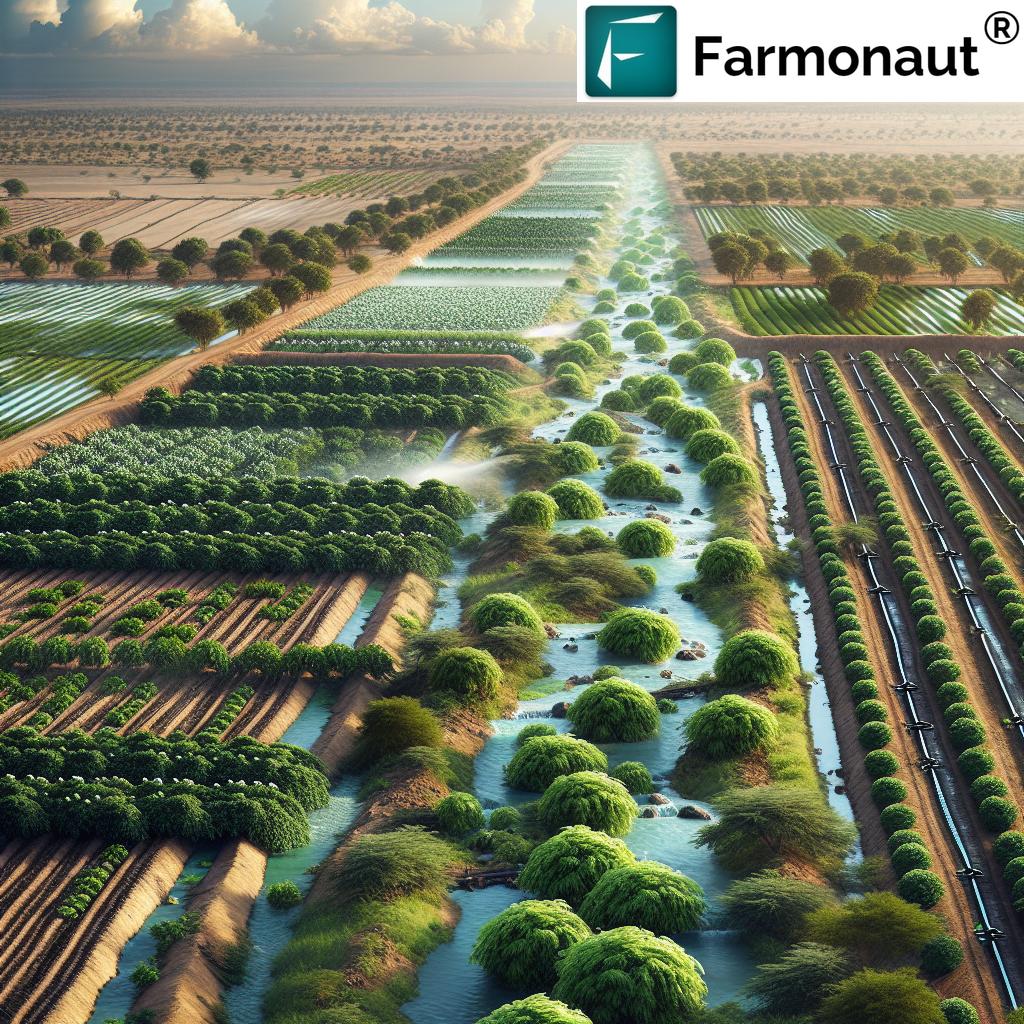Ancient Mesopotamia Agriculture: 7 Key Irrigation Systems that Shaped Sustainable Farming
“Mesopotamians built over 7 distinct irrigation systems, transforming barren land into fertile fields and supporting early sustainable agriculture.”
Table of Contents
- Mesopotamia & Agriculture: A Fertile Foundation
- Understanding Mesopotamian Climate Challenges
- The 7 Key Ancient Mesopotamia Irrigation Systems
- Comparative Overview Table: Ancient Mesopotamian Irrigation Systems
- Soil, Crops, and Early Sustainable Agricultural Practices
- Irrigation’s Role in Mesopotamian Society, Management, and Development
- Sustainable Water Management: Ancient Insights for 2025 and Beyond
- Ecological Lessons: Preventing Salinization and Land Degradation
- Leveraging Satellite & Digital Tools for Modern Irrigation: A Farmonaut Perspective
- Frequently Asked Questions (FAQ)
- Conclusion: The Ever-Evolving Legacy of Mesopotamian Agriculture
Mesopotamia & Agriculture: A Fertile Foundation
Ancient Mesopotamia agriculture is rightly regarded as the foundation of civilization. The vast fertile crescent—spanning Iraq, Syria, parts of Turkey, and Iran—is more than a historical geography lesson: it’s the birthplace of engineering marvels that made sustainable food and crop production possible in challenging, arid regions. At its heart, the Mesopotamian irrigation system proved crucial, offering lessons ever more relevant as we approach 2025 and face modern challenges in agriculture and water management.
Why does agriculture in ancient Mesopotamia matter today? Because their innovations in irrigation and soil management enabled urban development, population growth, and enduring advancements, laying a foundation for practices we still refine—sometimes with satellite-driven large-scale farm management—as sustainable food production becomes the core of our future.
Understanding Mesopotamian Climate Challenges: The Drivers of Innovation
The region between the Tigris and Euphrates rivers was a paradox—an alluvial plain with rich, fertile soil deposited by unpredictable flooding. Yet, the climate was dry and hot, rainfall was irregular, and natural water supply was unreliable. How could cities thrive here?
- The Problem: Constant risk of either flood damage or drought, making reliance on rainfall impossible and reliable crop cultivation a challenge.
- The Solution: Engineered irrigation systems: sophisticated, systematic networks of canals, dikes, levees, and reservoirs—managed strategically by 3000 BCE and before.
These feats of ancient engineering enabled large-scale, systematic management of both seasonal flooding and irrigation—tools and techniques with profound implications for sustainable agriculture and modern-day food security in arid regions.
The 7 Key Ancient Mesopotamia Irrigation Systems
Let’s delve into the seven principal irrigation systems that revolutionized agriculture in ancient Mesopotamia, unlocking the region’s full potential and seeding ideas that echo into 2025.
“Ancient Mesopotamian canal networks irrigated up to 10,000 square kilometers, showcasing early large-scale water management for arid regions.”
1. Main Canals (Primary Irrigation Channels)
These were extensive, engineered networks that directed river water far into fields otherwise out of reach from the wild Tigris and Euphrates. Main canals were central highways for water. While construction required immense labor, these structures could move vast water volumes—considered the keystone of Mesopotamian irrigation. By diverting and controlling seasonal flows, crop cultivation was possible nearly year-round, vastly expanding arable land and crop production.
2. Branch and Feeder Canals
Branch canals channeled moisture directly to smaller, specific fields and plots. Their flexibility allowed farmers to irrigate new land as needed, adapt to changing seasons, and ensure reliable food production.
3. Levees and Embankments
Levees (also called embankments) were defensive banks along rivers and canals, built to control flooding and prevent erosion of irrigated fields. These structures protected land far from riverbanks, conserving soil health and providing the first large-scale water management system tailored to local conditions.
4. Dikes (Flood Control Barriers)
When unpredictable flooding threatened, dikes provided a second-layer defense. These engineered barriers closely regulated water flow into and out of networks, helping mitigate salinization by allowing periodic flushing of salts from irrigated soil. This was critical for sustainable agriculture since salt build-up was a perpetual risk.
5. Field-Specific Furrow Systems
Furrows are narrow trenches or ditches—a technique to direct water efficiently through fields for specific crops. This system reduced water loss by evaporation, improved water allocation, and allowed farmers to tailor irrigation practices based on crop needs. This approach strongly influenced modern precision irrigation methods.
6. Reservoirs and Storage Basins
Reservoirs (artificial storage basins) collected and stored excess river water during the flood season. This made irrigation possible during dry periods or even droughts—an early form of resource management that speaks directly to modern water security in arid regions worldwide.
7. Water Lifting Devices (Shaduf & Pulley Systems)
The introduction of manual water-lifting devices—such as early pulley-operated shadufs—allowed farmers to raise water from lower canals or wells to fields on higher ground. This system expanded potential arable land, showing the intersection of technology, systematic irrigation, and human ingenuity.
Comparative Overview Table: Ancient Mesopotamian Irrigation Systems
| Irrigation System Name | Main Features | Estimated Construction Era (BCE) | Water Efficiency (Estimated %) | Area Covered (Estimated hectares) | Impact on Crop Yield (Est. % Increase) | Sustainability Relevance (Modern Advantage) |
|---|---|---|---|---|---|---|
| Main Canals | Large, engineered river diversion channels | c. 4000–3500 BCE | 60–70% | Up to 800,000 | 50–60% | Foundation of regional irrigation, large-scale farming; direct inspiration for modern engineered canals |
| Branch/Feeder Canals | Secondary water distribution to fields | c. 3500 BCE onwards | 50–65% | 100,000+ | 30–40% | Adaptable to local needs, prototype for modular irrigation systems |
| Levees & Embankments | Flood prevention, soil protection structures | c. 3300 BCE onwards | N/A (indirect) | Entire riverbanks, fields | Prevented losses | Core to flood protection and sustainable land management |
| Dikes | Water flow regulation, periodic salt flushing | c. 3200 BCE onwards | Improved by 15–20% | Tens of thousands | Reduced losses, stabilized yield | Early method for fighting salinization, now linked to drainage techniques |
| Field-Furrow Systems | Efficient, targeted water delivery | c. 3100 BCE | Up to 80% | By field type | Up to 45% | Prototype for modern drip/furrow irrigation |
| Reservoirs/Basins | Water storage for drought protection | c. 3000 BCE | Stored 100% | Thousands–tens of thousands | Critical stability | Modern water security and resilience |
| Water Lifting Devices | Shaduf, basic pulley systems, wells | c. 2500–2000 BCE | N/A (for reach, not volume) | Small/raised fields | Extended arable area | Early tech evolution; automated modern pumps and AI-assisted irrigation today |
Soil, Crops, and Early Sustainable Agricultural Practices
Success in agriculture in ancient Mesopotamia was not merely about irrigation. Maintaining soil fertility was vital, especially with soil at constant risk of salinization due to river water minerals. Here’s how Mesopotamian farmers laid early foundations of sustainable practices:
- Crop Rotation & Fallowing: Regularly rotating staple crops (barley, wheat, flax, legumes) allowed the soil to recover its fertility—a concept crucial in modern sustainable agriculture.
- Periodic Flushing: Canal and dike systems intentionally flushed out salts accumulated through irrigation. This solution to a common issue of irrigated agriculture remains relevant today.
- Early Record-Keeping: Cuneiform tablets detail instructions for planting dates, land leasing, crop yields, water allocation, and even penalties for water disputes—evidence of a sophisticated system and social governance.
Irrigation’s Role in Mesopotamian Society, Management, and Development
The ancient mesopotamia irrigation system influenced not only farms but also the framework of civilization itself. Building and maintaining large networks required:
- Organized Labor: Water management was a community project—from digging canals to repairing levees.
- Administrative Institutions: Rulers and temple authorities oversaw crucial irrigation maintenance, allocation, and dispute resolution.
- Resource Management: Decisions over water distribution, crop choices, and land leasing fed into the growth of complex social and political structures. This form of governance set the template for later civil societies.
In essence, agricultural development and sophisticated water management illustrate how sustainable practices and resource allocation are inseparable from societal progression—a deeply relevant lesson for 2025 as we face growing water scarcity and social challenges.
Our Farmonaut apps provide ongoing resource management, AI-based agricultural advice, and field monitoring—putting modern versions of ancient Mesopotamian irrigation control right into today’s farmers’ hands. Explore the Agro Admin App for large-scale farm management built on sustainability and efficiency.
Sustainable Water Management: Ancient Insights for 2025 and Beyond
Mesopotamian irrigation systems teach us the importance of:
- Strategically integrating hydraulic engineering with systematic governance for long-term food security
- Monitoring soil health to prevent salinization and yield drops
- Resource allocation and cooperation—whether by temple bureaucracy or modern digital platforms
How are these lessons relevant and valuable for today’s world?
- Food Security: Effective management of water resources, mechanisms for dispute resolution, and adaptation via new technology remain vital as the world grows drier and food demand soars.
- Sustainable Innovation: From AI-driven irrigation scheduling—inspired by furrow and branch canal logic—to carbon footprinting and environmental impact monitoring, the ancient system offers blueprints for modern sustainability.
- Digital Traceability: Blockchain-based product traceability brings Mesopotamian record-keeping to today’s global agri-supply chains, improving transparency.
Ecological Lessons: Preventing Salinization and Land Degradation
While irrigation guaranteed reliable food production, it came with ecological challenges still seen in 2025:
- Over-irrigation or poor drainage caused salt build-up, reducing yield and sometimes causing the collapse of entire city-states (e.g., Nippur).
- This highlights the importance of water monitoring, soil testing, and sustainable irrigation—all crucial in a world with shrinking arable land and growing desertification.
Farmonaut’s platform offers modern, data-driven tools for soil salinity monitoring, crop health analysis, and efficient resource management, giving us what ancient Mesopotamian farmers would have dreamed of—reliable, real-time insights for sustainable agriculture.
Leveraging Satellite & Digital Tools for Modern Irrigation: A Farmonaut Perspective
As we continue to strive for efficient agriculture in a changing climate, we at Farmonaut recognize that the principles from ancient mesopotamia irrigation system still lead the way—only now, we pair them with satellite imagery, AI advisory, and blockchain platforms.
- Satellite-Based Monitoring: Our apps and APIs bring real-time field and water management to every farmer, helping prevent ecological issues before they arise. For details, check our API documentation.
- Resource & Fleet Optimization: With fleet management tools, large farms can reduce operational costs by maximizing machinery and vehicle use—cutting wastage, just as ancient systems allocated labor efficiently.
- Loan and Insurance Support: Verified crop monitoring for lenders brings transparency and reduces fraud, echoing the reliability ancient Mesopotamian record-keeping offered.
- Sustainability & Traceability: For responsible farming and supply chains, our blockchain traceability guarantees authenticity—an advanced digital version of ancient tablets.
Our focus: make historical wisdom actionable, affordable, and accessible for any farm, anywhere.
Frequently Asked Questions (FAQ)
-
Q: What is the “ancient mesopotamia irrigation system,” and why is it important today?
A: It refers to the network of canals, dikes, levees, reservoirs, and water-lifting devices that enabled sustainable agriculture in ancient Iraq, Syria, Turkey, and Iran. Their design principles—resource management, organization, and sustainability—are extremely relevant to address modern water scarcity, food security, and climate change.
-
Q: How did Mesopotamians manage soil salinization?
A: They performed periodic flushing using controlled water flows (from canals and dikes) and implemented crop rotation and fallowing. Modern approaches use satellite and AI monitoring, technologies offered on Farmonaut’s platform.
-
Q: Are any Mesopotamian irrigation techniques used in 2025?
A: Yes! Techniques like main and feeder canals, furrow irrigation, and resource governance are the basis for today’s sustainable, precision, and even AI-guided irrigation systems.
-
Q: How can technology enhance irrigation now?
A: With satellite monitoring, AI analysis, and blockchain, it’s possible to optimize water usage, trace crops, and maximize yields, reducing the risk of environmental damage and economic loss.
-
Q: How can I use Farmonaut’s solutions for sustainable agriculture?
A: Using our apps, APIs, and desktop tools, you can monitor field water levels, crop status, and even carbon footprint, applying advanced solutions for long-term sustainability and yield improvement.
Conclusion: The Ever-Evolving Legacy of Mesopotamian Agriculture
The story of agriculture in ancient Mesopotamia is not just history—it’s a living lesson for all of us who strive for sustainable agriculture, resilient food systems, and smarter water management as we approach 2025.
Ancient mesopotamia agriculture set out the keystone principles of resource allocation, organization, and technological innovation—from magnificent canals to deft furrow designs—still echoing through every modern systematic irrigation project, and now, every satellite-monitored field or AI-advised farm.
By understanding and adapting the wisdom of early civilizations, we lay a sturdy foundation for sustainable food production, environmental stewardship, and thriving communities long into the future.
Ready for the next step? Discover how you can integrate sustainability and advanced monitoring into your farming with Farmonaut’s platform.










